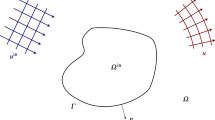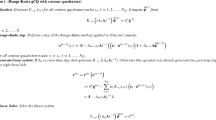Abstract
Transient problems can often be solved with transformation methods, where the inverse transformation is usually performed numerically. Here, the discrete Fourier transform in combination with the exponential window method is compared with the convolution quadrature method formulated as inverse transformation. Both are inverse Laplace transforms, which are formally identical but use different complex frequencies. A numerical study is performed, first with simple convolution integrals and, second, with a boundary element method (BEM) for elastodynamics. Essentially, when combined with the BEM, the discrete Fourier transform needs less frequency calculations, but finer mesh compared to the convolution quadrature method to obtain the same level of accuracy. If further fast methods like the fast multipole method are used to accelerate the boundary element method the convolution quadrature method is better, because the iterative solver needs much less iterations to converge. This is caused by the larger real part of the complex frequencies necessary for the calculation, which improves the conditions of system matrix.









Similar content being viewed by others
References
Aliabadi MH (2002) The boundary element method: applications in solids and structures, vol 2. Wiley, London
Banjai L, Sauter S (2008) Rapid solution of the wave equation in unbounded domains. SIAM J Numer Anal 47(1):227–249
Banjai L, Messner M, Schanz M (2012) Runge–Kutta convolution quadrature for the boundary element method. Comput Methods Appl Mech Eng 245–246:90–101. doi:10.1016/j.cma.2012.07.007
Cao Y, Rong J, Wen L, Xiao J (2015) A kernel-independent fast multipole BEM for large-scale elastodynamic analysis. Eng Comput 2015:2391–2418
Domínguez J (1993) Boundary elements in dynamics. Computational Mechanics Publication, Southampton
Duffy MG (1982) Quadrature over a pyramid or cube of integrands with a singularity at a vertex. SIAM J Numer Anal 19(6):1260–1262
Durbin F (1974) Numerical inversion of Laplace transforms: an efficient improvement to Dubner and Abate’s method. Comput J 17(4):371–376
García-Sánchez F, Zhang C, Sáez A (2008) 2-D ransient dynamic analysis of cracked piezoelectric solids by a time-domain BEM. Comput Methods Appl Mech Eng 197(33–40):3108–3121
Gaul L, Schanz M (1999) A comparative study of three boundary element approaches to calculate the transient response of viscoelastic solids with unbounded domains. Comput Methods Appl Mech Eng 179(1–2):111–123. doi:10.1016/S0045-7825(99)00032-8
Graffi D (1954) Über den Reziprozitätssatz in der Dynamik elastischer Körper. Ing Arch 22:45–46
Kausel E (2006) Fundamental solutions in elastodynamics. Cambridge University Press, New York
Kausel E, Roësset J (1992) Frequency domain analysis of undamped systems. J Eng Mech ASCE 118(4):721–734. doi:10.1061/(ASCE)0733-9399(1992)118:4(721)
Kielhorn L, Schanz M (2008) Convolution quadrature method based symmetric Galerkin boundary element method for 3-d elastodynamics. Int J Numer Methods Eng 76(11):1724–1746
Lubich C (1988) Convolution quadrature and discretized operational calculus. I. Numer Math 52(2):129–145
Lubich C (1988) Convolution quadrature and discretized operational calculus. II. Numer Math 52(4):413–425
Mansur WJ (1983) A time-stepping technique to solve wave propagation problems using the boundary element method. PhD thesis, University of Southampton
Messner M, Schanz M (2010) An accelerated symmetric time-domain boundary element formulation for elasticity. Eng Anal Bound Elem 34(11):944–955. doi:10.1016/j.enganabound.2010.06.007
Narayanan GV, Beskos DE (1982) Numerical operational methods for time-dependent linear problems. Int J Numer Methods Eng 18(12):1829–1854. doi:10.1002/nme.1620181207
Schanz M (2001) Wave propagation in viscoelastic and poroelastic continua: a boundary element approach. Lecture notes in applied mechanics, vol 2. Springer, New York. doi:10.1007/978-3-540-44575-3
Schanz M (2010) On a reformulated convolution quadrature based boundary element method. CMES Comput Model Eng Sci 58(2):109–128. doi:10.3970/cmes.2010.058.109
Schanz M, Antes H (1997) Application of ‘operational quadrature methods’ in time domain boundary element methods. Meccanica 32(3):179–186
Wheeler LT, Sternberg E (1968) Some theorems in classical elastodynamics. Arch Ration Mech Anal 31:51–90
Xiao J, Ye W, Cai Y, Zhang J (2012) Precorrected FFT accelerated BEM for large-scale transient elastodynamic analysis using frequency-domain approach. Int J Numer Methods Eng 90(1):116–134. doi:10.1002/nme.3316
Xiao J, Ye W, Wen L (2013) Efficiency improvement of the frequency-domain BEM for rapid transient elastodynamic analysis. Comput Mech 52(4):903–912. doi:10.1007/s00466-013-0852-9
Ying L, Biros G, Zorin D (2004) A kernel-independent adaptive fast multipole algorithm in two and three dimensions. J Comput Phys 196(2):591–626. doi:10.1016/j.jcp.2003.11.021
Zhang C (2000) Transient elastodynamic antiplane crack analysis in anisotropic solids. Int J Solids Struct 37(42):6107–6130
Acknowledgments
The first author gratefully acknowledges the hospitality and support by The Hong Kong University of Science and Technology during his sabbatical leave. The second author acknowledges Hong Kong Research Grants Council for supporting this work through Competitive Earmarked Research Grant 621411. The third author acknowledges the supports from the National Science Foundations of China under Grants 11102154 and 11472217 and the Alexander von Humboldt Foundation (AvH) to support his fellowship research at the Chair of Structural Mechanics, University of Siegen, Germany.
Author information
Authors and Affiliations
Corresponding author
Appendix: Butcher tableaus for the used Runge–Kutta methods
Appendix: Butcher tableaus for the used Runge–Kutta methods
In the test two 3-stage Runge–Kutta methods have been used. The respective Butcher tableaus are:
-
3-stage Radau IIA
$$\begin{aligned} \begin{array}{c|ccc} \frac{4 - \sqrt{6}}{10} &{} \frac{88 - 7 \sqrt{6}}{360} &{} \frac{296 - 169 \sqrt{6}}{1800} &{} \frac{-2 + 3 \sqrt{6}}{225}\\ \frac{4 + \sqrt{6}}{10} &{} \frac{296 + 169 \sqrt{6}}{1800} &{} \frac{88 + 7 \sqrt{6}}{360} &{} \frac{-2 - 3 \sqrt{6}}{225} \\ 1 &{} \frac{16 - \sqrt{6}}{36} &{} \frac{16 + \sqrt{6}}{36} &{} \frac{1}{9} \\ \hline &{} \frac{16 - \sqrt{6}}{36} &{} \frac{16 + \sqrt{6}}{36} &{} \frac{1}{9} \end{array} \end{aligned}$$ -
3-stage Lobatto IIIC
$$\begin{aligned} \begin{array}{c|ccc} 0 &{} \frac{1}{6} &{} - \frac{1}{3} &{} \frac{1}{6} \\ \frac{1}{2} &{} \frac{1}{6} &{} \frac{5}{12} &{} - \frac{1}{12} \\ 1 &{} \frac{1}{6} &{} \frac{2}{3} &{} \frac{1}{6} \\ \hline &{} \frac{1}{6} &{} \frac{2}{3} &{} \frac{1}{6} \end{array}. \end{aligned}$$
Rights and permissions
About this article
Cite this article
Schanz, M., Ye, W. & Xiao, J. Comparison of the convolution quadrature method and enhanced inverse FFT with application in elastodynamic boundary element method. Comput Mech 57, 523–536 (2016). https://doi.org/10.1007/s00466-015-1237-z
Received:
Accepted:
Published:
Issue Date:
DOI: https://doi.org/10.1007/s00466-015-1237-z




